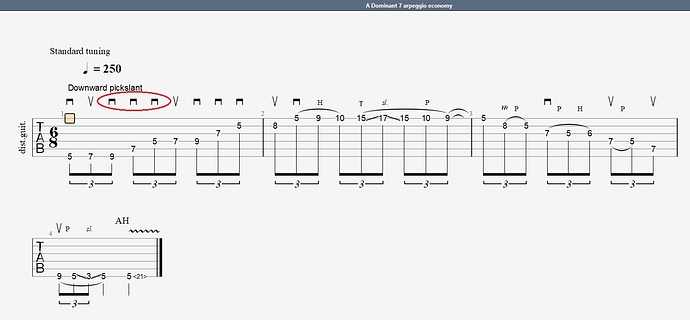So you’re saying you’re using the “correct” sequence of motions, but for some reason when you get to the initial note on the third string of your pattern, the one with the three consecutive diatonic notes, your pick just keeps going like you’re playing an arpeggio and hits the next string? What actually happens as a result of this, can you not play the three scale notes at all? Or does it just create a pause between the first and second note of those three notes?
This is a case where some video could be useful. Reason being, we haven’t spoken much about the “how” of actually doing sweeping, in terms of what physical motions are being used. But it could be that whatever you’re doing is activating different motions than what you would normally use for just playing those alternate notes on the string itself.
In the forearm section of the Primer, we tried to look at this a little bit in the most recent sequence of chapters we uploaded. In my case, for that motion in particular, when I’m doing economy type stuff, since it’s a hybrid motion that fuses forearm and wrist together the sweeping part of the conomy phrase looks to be sort of an extension of the wrist part of the motion, i.e. the tail end. Whereas the note on the lower string looks more like forearm.
So it’s tricky, and I think it’s a really interesting question of exactly how to “do” sweeping that we’ll have to boil down eventually, and seeing what different people are doing, like yourself, could be helpful.
I’d also mention the Oz Noy pair of interviews for tons of great economy examples. Lots of great arpeggio and other cool fusiony sequences there.
More practically speaking, what can you do here? Well, assuming there’s nothing actually “wrong” with your mechanics, and you’re just making the wrong sequence of motions because you’ve previously memorized the arpeggio-style sweeping thing, I like to go with what’s working right now. In other words, I try not to hammer away on the phrase that’s failing, but instead try to find similar ones that are working and play those instead. If those phrases are just similar enough, it may be that when I come back to the problematic one later on, that I no longer have the problem.
So in your case, you’re looking for any phrases that combinations of 3 and 1, but it doesn’t have to be identical to this one, and it doesn’t even have to be strictly ascending. Again, I’ll mention Oz because there are so many cool things he played where I was like, I’m totally going to try that! But then we got busy and I never got back to it. Here’s a great one, for example:

